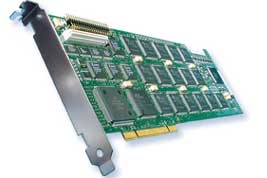HARDWARE SYSTEM REQUIREMENTS
Pentium 4 or equivalent, 2 GHz or better
PCI motherboard or passive backplane with 3.3V ATX power supply
PCI 2.2 bus
|
OPERATING SYSTEMS
Windows Server 2003 · Windows 2000 · Windows XP · Linux (Call for availability) |
|
TECHNICAL SPECIFICATIONS
Max boards per system:
4 (256 ports) - may be limited by platform performance
Resource Sharing Bus: MVIP or H.100
Control Microprocessor:
Motorola ColdfireT RISC (50 MHz)
DSP:
Multiple Texas Instruments TMS320C5402
Boards errors: On-board LEDs
Clocking: Master/Slave
DRAM: 16 MB per board
SRAM: 128 Kword/DSP
|
ENVIRONMENTAL CONDITIONS
Operating Temperature: 0C to +60C
Storage Temperature: -20C to +85C
Humidity: 8% to 80% non-condensing
Storage humidity:
8% to 80% non-condensing
PHYSICAL CHARACTERISTICS
Form Factor: Full-size PCI card
|
HOST INTERFACE
Bus Compatibility: Complies with PCISIG Bus Specifications, Rev. 2.2
Bus Speed: 33 MHz
Bus Mode: 32 bit bus master/target
Shared Memory: 16 MB Global shared RAM
SDK
Ai-Logix Native SmartWORKS™ API
SmartControl (Control Panel)
SmartVIEW (card functionality test application)
SmartWF (firmware flash update utility)
POWER REQUIREMENTS
+3.3 VDC: 2.5 Amp
+5 VDC: 5mA
-12 VDC: Not Required
+12 VDC: 20 mA
|
TRIGGER CONDITIONS
Event-Driven Caller ID · Min/Max silence · Min/Max activity
AUDIO SIGNAL
Receive range: -68 dBm to + 3 dBm
Input gain control: +24 to -64 dB
Silence Detection: Programmable from API
Transmit volume control: +24 to -50 dB
Automatic Gain Control (AGC): Programmable from API
Automatic Volume Control (AVC): Programmable from API
Activity Detection: Programmable from API
Alert Tone: Programmable from API
Frequency Response: 300 - 3400 Hz (+/- 3dB)
|
AUDIO DIGITIZING (ENCODING & DECODING)
8 Kb/s: G.729A
13 Kb/s: GSM 6.10, Microsoft GSM
16 Kb/s: G.726
24 Kb/s: G.726, OKI
32 Kb/s: G.726, OKI
40 Kb/s: G.726
64 Kb/s: µ-law or A-law per G.711, 8 bit linear PCM
128 Kb/s: 16 bit linear PCM
Wave file formats: Microsoft GSM, 16-bit PCM, 8 bit Unsigned
Digitization selection: Programmable per channel, independent for
encode and decode
GLOBAL TONE GENERATION
Tone Type: Single or dual frequency
Frequency range: 300 Hz - 3400 Hz
Frequency resolution: 1 Hz
Duration: 1 ms - 8191 ms programmable in 1 ms steps
Amplitude: +3 dBm to -68 dBm
|
DTMF/MF TONE DETECTION
DTMF digits: 0 - 9, *, #, A, B, C, D
MF R2 Digits: 15 Digits Forward & Reverse per Q.441
Dynamic range: -38 dBm to 0 dBm
Minimum tone detection: 40 ms
Interdigit timing: 40 ms min.
Acceptable twist: Per LSSGR sec. 6, 8 dB forward, 4 dB reverse
Frequency variation: Accept all +/- 1.5%, reject all +/-2.5%
Noise tolerance: Per LSSGR sec. 6
Talk off: Bellcore TR-TSY-000762
CALL PROGRESS MONITORING
Number of programmable tones: 20
Number of bandpass filters: 10
Number of filters per tone: 1,2, or 3
Number of cycles: 0 to 255
SIT tones: Yes, programmable frequencies and duration
Answering Machine Detection: Yes
|
TONE DIALING
DTMF digits: 0 - 9, *, #, A, B, C, D
Frequency variation: Less then 1 Hz
Rate: API Programmable
Duration: API Programmable |
VOICE PROCESSING
Echo cancellation: G.165
Caller ID: V.23 & Bell 202
DTMF Detector: Primary & Secondary channel
MF Detection: R1 & R2
|
SAFETY AND CERTIFICATIONS
Telecom: DOC
Emissions: FCC Part 15 class A · EN 55022
Immunity: EN 55024
Safety: EN 60950
Estimated MTBF: 150,000 hours per Bellcore Method I |
|
| |
|
|
|



